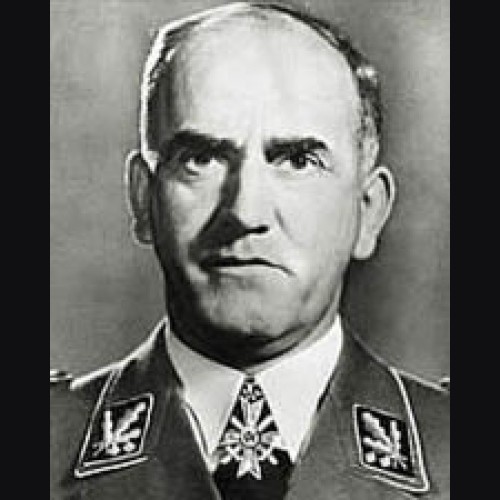A2. Oswald Pohl # 494
In 1925,Oswald Pohl became a member of the SA, then finally joined the re-founded NSDAP in February 1926 as member #30842. He met Himmler in 1933 and became his protégé; he was appointed chief of the administration department in the staff of the Reichsführer-SS and given the rank of SS-Standartenführer in 1934 and began to influence the administration of the concentration camps.
His career continued when he was made Reich's treasurer for the SS 1935, then initiated the inspection of the concentration camps, to organize and oversee the administration of the concentration camps. He also founded the the Society for the preservation and fostering of German cultural monuments, which was primarily dedicated to restoring the Wewelsburg, an old castle that was supposed to be turned into a cultural and scientific headquarters of the SS at Himmler's request. The "society" soon became a part of Pohl's SS administration office.
Pohl became chief of both the main bureau for administration and economy", part of the SS) and the main bureau for budget and construction", part of the Reichs's ministry for the interior). In February, 1942, both institutions were combined into the SS main bureau for economic administration with Pohl in charge; among other things, in charge of the organization of the concentration camps, deciding on the distribution of detainees to the various camps and the rental of detainees for forced labor until 1944.
Pohl was made SS-Obergruppenführer and General of the Waffen-SS in April 1942; In December 1942 the same year, after divorce from his wife, he married Eleonore Von Bruning, a widow and skilled porcelain designer.
In 1944, Pohl was put out of charge of the concentration camps, with the ministry of armament overtaking; at the same time, the responsibility for construction was also taken away. However, Pohl remained in charge of the administration of the Waffen-SS for the remainder of the war. Pohl's presence with the Allach factory can be seen by his commercial Juhlfest plates and tied in through period correspondence in regards to both Allach and Bohemia porcelain works. The latter employed his wife as a designer and consultant for both porcelain entities.
After the end of WWII in 1945, Pohl first hid in Upper Bavaria, then near Bremen; nevertheless, he was captured by troops in May 1946 and sentenced to death in November 1947 by an American military tribunal after the Nuremburg trials for crimes against humanity, war crimes and membership in a criminal organization as well as for mass murders and crimes committed in the concentration camps administered by the SS-WVHA he was in charge of. However, Pohl was not executed right away.
Pohl was hanged in 1951 at Landsberg after a series of appeals. His typical defense was that he was merely a functionary.
In 1925,Oswald Pohl became a member of the SA, then finally joined the re-founded NSDAP in February 1926 as member #30842. He met Himmler in 1933 and became his protégé; he was appointed chief of the administration department in the staff of the Reichsführer-SS and given the rank of SS-Standartenführer in 1934 and began to influence the administration of the concentration camps.
His career continued when he was made Reich's treasurer for the SS 1935, then initiated the inspection of the concentration camps, to organize and oversee the administration of the concentration camps. He also founded the the Society for the preservation and fostering of German cultural monuments, which was primarily dedicated to restoring the Wewelsburg, an old castle that was supposed to be turned into a cultural and scientific headquarters of the SS at Himmler's request. The "society" soon became a part of Pohl's SS administration office.
Pohl became chief of both the main bureau for administration and economy", part of the SS) and the main bureau for budget and construction", part of the Reichs's ministry for the interior). In February, 1942, both institutions were combined into the SS main bureau for economic administration with Pohl in charge; among other things, in charge of the organization of the concentration camps, deciding on the distribution of detainees to the various camps and the rental of detainees for forced labor until 1944.
Pohl was made SS-Obergruppenführer and General of the Waffen-SS in April 1942; In December 1942 the same year, after divorce from his wife, he married Eleonore Von Bruning, a widow and skilled porcelain designer.
In 1944, Pohl was put out of charge of the concentration camps, with the ministry of armament overtaking; at the same time, the responsibility for construction was also taken away. However, Pohl remained in charge of the administration of the Waffen-SS for the remainder of the war. Pohl's presence with the Allach factory can be seen by his commercial Juhlfest plates and tied in through period correspondence in regards to both Allach and Bohemia porcelain works. The latter employed his wife as a designer and consultant for both porcelain entities.
After the end of WWII in 1945, Pohl first hid in Upper Bavaria, then near Bremen; nevertheless, he was captured by troops in May 1946 and sentenced to death in November 1947 by an American military tribunal after the Nuremburg trials for crimes against humanity, war crimes and membership in a criminal organization as well as for mass murders and crimes committed in the concentration camps administered by the SS-WVHA he was in charge of. However, Pohl was not executed right away.
Pohl was hanged in 1951 at Landsberg after a series of appeals. His typical defense was that he was merely a functionary.



